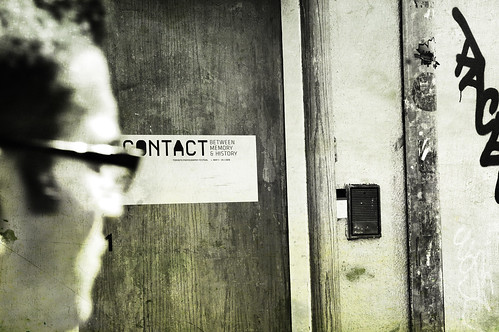Saturday was such a treat! Seeing Mapplethorpe’s work on the wall gave me a much better sense of what fine prints they are than looking in books many years ago. I was a bit disappointed that the collection only contained his pretty images, not the more challenging images. But only a bit, because every single image was breathtaking.
The gallery that showed his work is a converted industrial space with like 30 foot ceilings; when I was there it was quiet as a church. Looking at his photos, I felt something almost religious. As long as I was looking at the photos, I felt good, but as soon as I started to explore the gallery, I felt awkward, like I didn’t belong in that ritzy gallery world. When I went to the bathroom, I discovered that the feeling of having my fly down wasn’t just metaphorical. Oh well.
Next up was a lecture and slide show from David Hurn, a photojournalist who’s been with Magnum since like 1967.
A few highlights from the lecture that really resonated for me:
- insatiable curiosity is a must-have for photographers (Hurrah, now I don’t have to feel guilty for being such a nosy parker)
- the daughter of one of his subjects (from an MG car owners’ ball) wrote him not long ago, several years after her dad died, to tell Hurn how much joy seeing her father’s picture published everywhere brings her.
- Hurn said it was really nice to hear from her because he never asks permission to make photos, despite the constant worry of intruding on people’s space (though he dismissed that notion quickly enough as academic).
- that reminded me of two articles I just read last week, both in the New Yorker, about Jill Freedman. The first article found its way into one of her subject’s hands, and he hadn’t known about the photo (it was shot back in the 70s or 80s) until very recently. The bottom line was he was happy to discover the photo.
- he’s worked on several projects involving poets choosing one of his photos to write about, and writing a poem to accompany it. I may want to try this out sometime. He says it doesn’t work the other way around – making photographs to illustrate poems.
- he mostly only shoots with two lenses: a 28 mm and a 50 mm
- he once spent 32 days working intimately in an Arizona hospital with a great infant mortality rate
- he once worked as a cleaner in a strip club for 10 days to try to find a way to photograph naked ladies. It worked, when one of them mentioned that she needed a passport and he offered, and it grew from there.
- he finds contact sheets more interesting than individual prints, especially from students, because contact sheets show you how a photographer works, how they shoot.
- he ended his slide show with the most important photo ever in his life: his colon cancer. Just to make sure we don’t get too arrogant, the most important picture in his life was taken by a doctor with a camera up his ass.
- in the questions section, he mentioned that he doesn’t pay conscious attention to light, but on the content. He then moves into what he thinks is the best place to see the real content most clearly, and shoots. Of course he does probably notice the light and other elements subconsciously. I kind of shoot this way, and I sometimes feel like I should think more before shooting. But I really prefer to think after.
- he doesn’t much care for digital, not because what’s in the back of the camera really matters, but because people have a tendency to manipulate (like that’s a bad thing! Or like film photographers don’t do that in the darkroom!). He also thinks digital shooters stop shooting too soon – they take a shot, look at the screen, figure they got a decent shot, and stop shooting. But if you keep shooting, and you wait for something more to happen, it usually does and you get an even better shot.
- As soon as I came home, I told my husband about that last point, because if we’re out together, he’s always nagging at me to stop shooting already.
It was quite a long lecture, though I didn’t notice until I was back on the street and was surprised by how late it was. (Good thing I’d been to Robert Mapplethorpe already because I was pretty done.) There was an exhibition that I’d earmarked within a couple of blocks, though, so I decided to check it out before heading home.
The exhibition I expected wasn’t there (apparently noticing start and end dates is not my forte), but instead there was a small collection of street photography. There were the usual suspects: Cartier-Bresson, Eugene Atget, André Kertesz, but also some Canadian work, including a few shots from Toronto and Montreal in the winter of 1971, the one that everyone was talking this past winter when the snow just wouldn’t quit. 1971 is also the same winter my parents always talk about because my sister was born that winter and the streets were so bad my dad had to walk miles to the hospital for visits. One image in particular, by Michel Lambeth, stopped me utterly. It was titled St. Lawrence Market, Toronto, from 1957, and it showed a women holding an old glass pepsi bottle with a mass of shopping bags near her feet, and an open door just on the edge of the frame. It was so simple an the light coming in the open door was stunning. I was hoping to find a copy online but only this collection with many of the images not available.
The only way Saturday could have been any better was if I’d somehow found a mentor. Anyone out there interested in the job?
